A SPECIAL ACKNOWLEDGEMENT
|
We, the readers
of this history
booklet owe
a great debt of
gratitude
to Jean Dahl,
Administrative
secretary of the
Loyal/York
Center United
Methodist
Churches. Without
her research
and gracious
labors, this
booklet would not
have become
a reality.
From the bottom
of my heart,
and on behalf
of all the readers,
I give you
my sincere thanks.
Rev. Evan
G. Butterbrodt
|
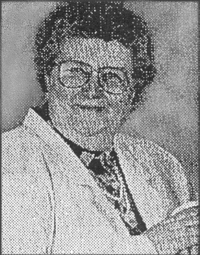
Jean Dahl
|
IN THE BEGINNING
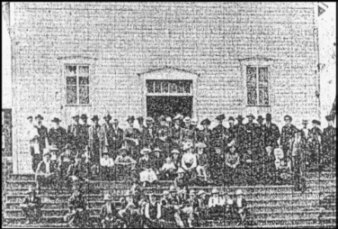
From "An Overview of
The Life of The Loyal, WI United Methodist Church 1870 - 2000
By: Jean Dahl
Visit The American Local History Network!
It was the original platting of the
Village of Loyal in 1870 when the first firm foundation of the Methodist Church
was laid. Before coming to Loyal Township, Rev. John Graves, a minister at Wautoma,
platted the land for a church.
The Loyal-Greenwood charge of the
Methodist Episcopal Church had been set aside in 1870. At the annual conference
in the fall of 187 1, Rev. Samuel E. McLain was appointed to serve the charge.
According to the records he must
have worked to organize a church by December 3, 1871. The charge to which lie was
assigned included the area beyond what is now Christie, north to Longwood, east
to Riplinger and then to Dorchester. Then the boundary turned south to McMann's
Comer, better known as Mannville and followed back in the general direction of Christie.
Rev. McLain traveled these trails
along with the help of many local preachers, both ordained and self-appointed, but
not officially recognized. The original charge had a transfer of members from the
Neillsville circuit. There were 51 who transferred, as well as 9 others who transferred
by letter on or before that December 3rd.
|
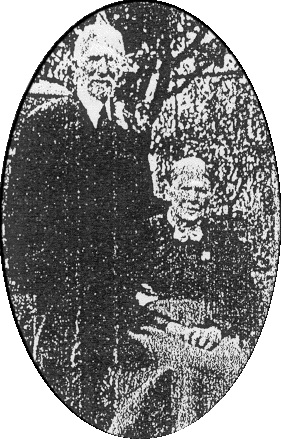
|
Rev. Horace Draper
and his wife Lucia
were early workers in the
ME Church. It is believed that Horace was probably the first Sunday
School Superintendent. The classes met in several different places -
the Mack School, Cole School, Greenwood School, Spokeville School, the
Hall School northeast of Loyal and in a hall over the store on the comer
of Mill Street and Union Street. More than likely this is where the
church service was also held. Salaries at this time were between $500
- $800, but pastors most likely received only a portion.
|
A young minister right out of school,
Rev. John J. Garvin was sent to the charge in 1875. It was at this time that the
first church was built. During the original platting of Loyal, a Deputy Surveyor,
Wm. Welsh, dated it February 13, 1874 and duly recorded it in the name of the Methodist
Episcopal Church of Loyal and Greenwood Circuit, Chippewa District of the West Wisconsin
Conference.
Money was scarce but people were
there to lend a hand. Some gave lumber, others gave saw logs. John Graves sawed
the logs as part of his subscription. A bee was held to haul the stones for the
foundation. Later another was held to do the lathing. The foundation was laid by
local masons and local contractors built the 30 x 60 foot structure with 14 foot
posts. The plastering was done by two other men.
In 1879 the Greenwood-Loyal charge
was separated and Loyal became a charge with York Center. Since there was no parsonage
in Loyal, they joined with Spencer. The following year Loyal was supplied with a
minister from Greenwood, but later was put back with Spencer. Several ministers
were assigned here but none stayed long.
It was at Fall Conference in 1883
that G. N. Foster was appointed to the Loyal Charge. During his first winter, with
very little money in circulation, plans were made for building the first parsonage.
Again there were donations of lumber, paint, building paper and labor. Money was
collected for the saw bill, plaster, doors, hardwood and such. At Conference it
was reported that the parsonage, worth nearly $800.00, had been built and nearly
paid for. There were 130 members at that time. It was at this time that York had
a new church at a cost of $225.00 with $140.00 indebtedness.
In 1887 the annual conference at
Mineral Point appointed Rev. L. W. McKibbin to the Loyal Charge. He was an architect
by profession and is credited with designing the present church. In the conference
report it was noted that in the Eau Claire District, school houses were being closed
to church usage, so a tent was purchased (don't know if the Conference or Loyal
Charge purchased the tent).
The Rev. S. A. Hoffman was assigned
to Loyal in 1893. He came from the German Evangelical Conference. Although he was
reported as being handicapped in finding English words to express himself, it didn't
hinder his efforts in adding over a hundred probationers with a greater number of
them becoming members in full connection.
By this time the congregation had
outgrown their place of worship. In the fall of 1894, the trustees decided to build
a new church. The subscriptions started with enough success to warrant the commencement
of building. The old building was sold for a sum recalled as $250.00. The new owners
had to move it to the other end of town as soon as weather permitted. It was then
used as an opera house and a community building. It later burned in 1905.
The building stone for the basement
was dug at Noeldner's hill and piled in die fall, ready to be hauled by teams of
sleighs during the winter. Much of the labor was again donated. The wall was built
by Joseph Mack and Rev. Hoffman who had been a stone mason in his youth. They competed
to see who could put die largest rock in place alone. The wood used in the construction
was from timber locally grown. It was again sawed by the Graves Saw Mill, at this
time owned by die son of John Graves. The finner mill work was done by Etta Brothers
who did all kinds of wood turning and finishing at the time.
The Loyal Tribune Headlines in their
September 16, 1896, paper read:
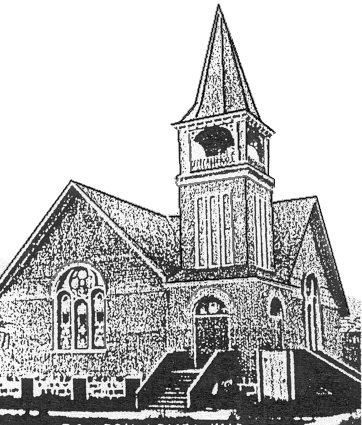
CHURCH DEDICATED
++A DEBT OF $950.00 WIPED OUT++
NEW M.E. Church in LOYAL
The first paragraph of the news
article read as follows: "As if in consideration f the services consecrating o the
new temple to His service, the Lord held back the clouds that looked so threatening
on last Sunday morning and there was a good congregation at morning, afternoon and
evening services of dedication day. The extreme harmony of the occasion was somewhat
marred by the failure of the windows and pews to arrive in time to be put in place.
The old and uncomfortable pews that were of necessity substituted for the new and
elegant ones were, however, crowded to the uttermost and the large audience forgot
their discomfiture in their intense interest in the services."
Dr. Forbes was the main speaker for
the dedication services. He must have had a great effect on the audience because
at the close of the morning service there was a indebtedness of $950. Rev. S. A.
Hoffman and Rev. G. N. Foster began a campaign of subscriptions and shrunk the debt
by $517.00 at the close of the morning session. During the day G. W. Allen and Rev.
Hoffman took it upon themselves to go out and raise $ 100.00 each from among those
who were not present. In the evening the two ministers again continued their pilgrimage
through the audience until the last dollar was either pledged or in sight.
"If it had been prophesied by
anyone a year earlier that Loyal would, within so short a time, be able to build
and pay for a church of this kind at a cost of $4,000., he would have been called
crazy. Yet there it stands, a lowering reality, the pride of the village and especially
of those who have contributed of their meager means to its erection." The Ladies
Aid Society was the largest contributor. There were a couple $ 100.00 donations
along with 75 gifts ranging from $.50 to $5.00. Rev. Hoffinan's manual labor was
estimated by others to amount to about $250.00 at the rate of $1.25 per day in giving
the figure of $4000. for the cost of the church.
| At the time of the 80th anniversary, the Rev. James
A. Hill was the pastor. Ms wife was the Sunday School teacher for the
young women and Mrs. B. W. Colby taught the young men. There were 16
taken into full membership on August 21, 1904. At the time of the Centennial
in 1971, two of those young were still active in the They were Ray Prior
and J. R. Thomas. |
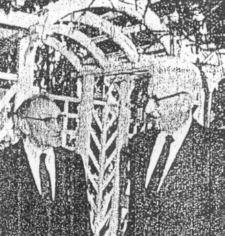
Ray Prior & J. R. Thomas
|
In 1914 when Rev. Thomas Harris was
the pastor, the parsonage was completely rebuilt. The Rev. W. P. Powell's were the
first to occupy it.
The Rev. V. C. Kegley came in 1930,
but passed away in 1931, the first death of an appointed pastor. During a service
in 1934, when 26 were received into full membership or as preparatory members, there
was also a dedication of a new pulpit Bible in memory of Rev. Kegley. Mr. and Mrs.
O. W. Trindal presented the Bible for dedication.
The church property had under gone
changes from time to time (1936- 1939) and one of the changes was the appointment
of Rev. Raymond J. Fleming. During his stay the walls and ceiling were covered with
NuWood. For a time the emblem of the Epworth League had adorned the wall behind
the altar. New lighting fixtures were also added at this time. Rev. Myron Taylor
continued modernizing the church with the installation of restrooms in the basement.
A garage was also built for the pastor's automobile.
Rev. Lee Holmes and his family graced
our church in 1946. His son Virgil followed in his father's footsteps by beginning
his studies for the ministry. In time lie was a student pastor at York Center and
Lindsey churches.
There were numerous improvements
made at this time: the rejuvenation of the church basement by repairing and redecorating
the and covering the cement floor with tiles, remodeling the kitchen and installing
an electric range and adding an oil heater to the main room of the basement. Many
memorials were given toward the purchase of a new electric organ.
The Rev. and Mrs. Willard Mecklenburg
only spent a year here before continuing their ministerial work in Alaska. They
sent many reports of their work, giving the feeling of another missionary working
from our church.
In 1960, we received an appointment
of a family with young children, Rev. and Mrs. Paul Doering. Sheila was well known
for her English goodies and the choir had the pleasure of their voices and other
musical talents, including Rev. Doering's violin solos. Construction of an educational
unit, addition, and moving of the parsonage were in Ole planning stage for several
years, but did not reach reality during their stay. Several members of the church
were honored during this time, namely, Mr. and Mrs. Ray Prior, J. R. Thomas, Herbert
White, Mrs. Mardia Castner and Mr. and Mrs. Richard Giese. It is believed that the
new front was put on the church in 1965.
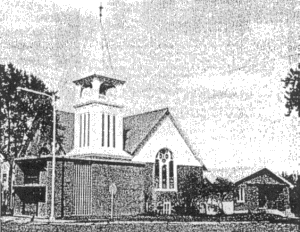
The next couple to become a part
of our community were the Revs. Lelan and Ellen Shaw, both ordained in ministerial
work. It was at that time the actual construction of the new educational unit began.
The Shaws were replaced by Rev. Conrad Mickelson in the fall of 1968.
Rev. Mickelson served our churches
until 1971 and added a touch of music with marimba solos during the morning worship
services.
Now it is time for the 100th anniversary
and the Rev. Gene Carlson was here to help plan for the occasion. During Rev. Carlson's
stay several events took place. First the burning of the mortgage for the education
unit and then the dedication service. In 1976 a public address system was installed
in memory of Claude and Sara Catlin.
| When 1977 came, so did the Charles and Lurinda Sandford.
They lived in the Greenwood the parsonage where Rev. Lurinda served
as pastor and also at the Christie Church. Rev. Charles had Loyal
and York Center Churches. During the time they lived in Greenwood
the parsonage burned and Rev. Charles moved to an apartment owned by
John Olsen. Rev. Lurinda later was appointed to a charge up north, possibly
Minocqua, and Pastor moved into the Loyal parsonage. Plans for the new
parsonage got under way in 1979 and it was built in 1982. The old parsonage
was sold. At Annual Conference in 1982, Granton Church was put with
the Loyal-York Center charge. This made for a hurried Sunday morning
service for York Center and Granton. |
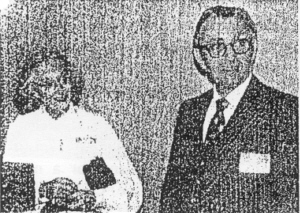
Revs. Charles and Lurinda Sanford
|
|
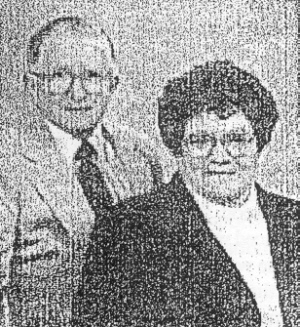
Rev. C. Arlene Denzer
|
This three point charge only lasted for five years.
At Annual Conference in 1987 Granton was put back with Neillsville and
we became a two point charge again. Rev. C. Arlene Denzer was our pastor
from 1983-1990. A new elevator was installed in 1987 and dedicated in
1988. In March 1989 the remodeling of the church restrooms began. The
following year a new organ and new hymnals were purchased. Rev. C. Arlene
and retired Rev. Lloyd were both musically gifted. She loved playing
the piano and he could play a "mean" saw. |
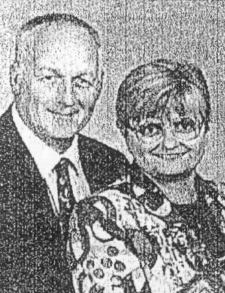
Rev. Steve Groves
Rev. and Mrs. Steve Groves were appointed
to our charge in 1990. fit in with everyone in the Community. Rev. Steve getting
involved with other groups outside the church and Sharon always there ready to lend
a helping hand whenever asked. Pastor Steve set up the food pantry along with
Social Services, running it out of the parsonage. New pew Bibles were purchased
and the biggest event of all, starting the plans for a new church. Rev. Steve
Groves was appointed to the Colfax-Tainter Charge in 1996.
| When the Groves left our next appointment was Rev. Sharon
Stewart John and husband David. She was only with us for a short time.
She was a very sincere and caring person. David enjoyed working with
the youth and cooking. It was during this time that the old wood furnace
was replaced with three new gas furnaces. Though there were good memories
of the wood-cutting bees and the early morning firings, no one has missed
all the work and early hours made necessary by one hundred and one years
of wood firing. |
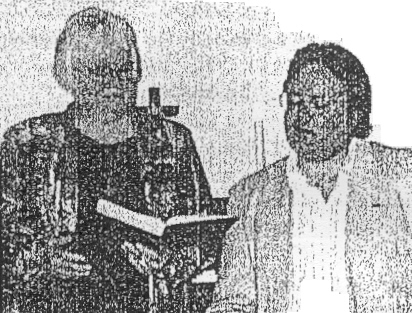
Rev. Sharon
Stewart
|
|
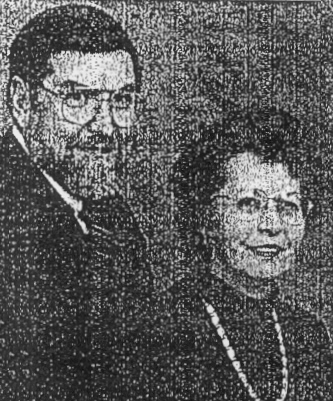
Rev. Evan & Judy Butterbrodt
|
The 1997 appointment brought us a couple who were native
Wisconsinites, Rev. Evan & Judy Butterbrodt This being the computer
age worked out very well, as with Pastor Evan came a computer to the
church office, making the work there easier. At this time he moved the
office from the parsonage to the Educational Unit and also moved the
food pantry into a room he built off of one of the Sunday School rooms.
He is such a perfectionist and it shows in his work. He enjoys
rebuilding old clocks, building and refinishing furniture and singing.
Judy is the bookkeeper for the Marshfield School District, but finds
time to help at church dinners, sing in the choir, work with the youth
fellowship and be with their grandsons. Pastor Evan keeps himself
very busy, especially at this time working on the New Church Project.
Several times a month he visits homes and nursing homes, and has Bible
Studies and worship services in the nursing homes. |
Our best built and most beautiful
churches would be nothing if it weren't for those dedicated people who put their
hearts and souls into keeping the churches going. The best laid plan is nothing
without someone there to take hold and make things work. If the young children are
not taught from little on and continued to be taught the Gospel of our Lord, our
churches will cease to exist. Although one never stops learning, it seems like everyone
has to have that little push. This is where our Sunday School Classes come in. Horace
Draper was probably the first Sunday School Superintendent. Later his son Fred,
Fred's wife Amy and their daughter Bernice continued the work Fred's father started.
Another important position is die Sunday School Secretary (now Chairperson of Education),
whose job was to order supplies for the various classes.
A special highlight of each year,
starting with the early days until present, is the Christmas Eve program. Sometimes
they get very elaborate and others may only be singing, but the meaning is still
the same. Vacation Bible School is held every year after the public school
is out for the summer. The children put on a program in the evening of the
last day of Bible School. The Sunday School children participate in the Sunday
worship service once a month with special music. It takes dedicated people
to keep this all going. Last but not least is the confirmation class.
The youth are in the seventh or eight grade. The class is taught by the pastor
of the church. They usually attend class for a couple hours each week.
| This church has always been very active in missions.
Through her many years of dedication, Dorothy Prior - long time Mission
Chair - has kept Loyal UMC quite visible in the area of missions. Some
of the projects have been the Heifer Project, support of foreign missionaries,
collect Campbell labels, stamps, and mittens for Northcott House--just
to name a few. |
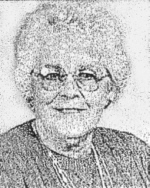
Dorothy Prior
|
We can't forget the Men's and Women's
groups of the church. The women's organization started in January of 1905
and was called "Ladies Aid." In 1941 the name was changed to WSCS or Women's
Society of Christian Service. They had a total of 62 charter members.
It was amazing what these ladies could do in the kitchen. With all their hard
work they managed to donate many things to the church. There was money donated
toward the rug fund. A carpet sweeper was purchased for $6.95 and a kitchen
range for $7.50. In 1944 the bazaar supper was canceled because of the war
and the rationing of many items, one of which was meat. They were only allowed
180 meat stamps and that wasn't enough to purchase meat for the supper. The
cost of a meal was $.60 for adults, $.35 for school children, and $.25 for pre-school
children. Loyal was credited with being the first Women's Society in the district
to subscribe to the the "Penny a Day Movement Fund". They sold greeting cards,
Christmas cards, creme shampoo and vanilla to earn money for the item they donated.
In about 1933 the knives and forks were stolen from the kitchen. The Ladies
Aid held a spoon shower to replace the items. Sometime after 1971, the name was
changed again. It is now called the United Methodist Women. Prices for the meals
have increased, but the women are still raising money and donating it back to the
church. They serve meals for weddings, funerals, special occasions and entertain
other community church groups. They now attend World Day of Prayer with other churches
in the community.
The men weren't going to let the
women outdo them as they also did many things to cam money. At first most of their
spare time was spent in die woods making fire wood for the furnace in the church.
The Men's' Club was chartered in 1956. They had the responsibility of finding pastors
or speakers in the absence of the regular pastor. Some of the social events they
have sponsored are the Father-Son Banquet, New Year's Dinner, Pancake Suppers, Homemade
Ice Cream Socials. They also served for the Mother-Daughter Banquet. In 1932 adults
paid $.30 and the children $.15 for the pancake suppers. They've had spaghetti dinners,
chicken pie suppers, organized auctions and basically did most of the repairs that
had to be done on the church. Most of the funds raised have been given to the youth
attending fellowship camps, ministerial and missionary students and missionaries
in the field as well as places of need on our own church comer. This would include
helping with the clean-up of old brick and other debris when the new front was put
on the church.
There was also the Epworth League
or Youth Fellowship or the Adult Christian Fellowship. It is believed that Rev.
Hoffman organized the Epworth League along with W. J. James who had been assigned
as assistant pastor. These groups have given their support to the church. The elegant
pews of polished oak as well as the cathedral style windows of, leaded stained glass
arrived after the dedication. The Epworth League and the G.A.R. each gave $13.00
for memorial windows which is believed to be the cost of the entire window according
to other prices at that time. The Methodist Youth Fellowship (MYF) had many worthy
fund raising projects and took part in district conventions and sub-district rallies.
In recent years, car washes were a means of raising money along with a spaghetti
dinner and dessert auction. Other activities include; roadside cleanup, bake cookies
for shut-ins, lead the Sonrise service on Easter Sunday, serve the Easter breakfast
and take part in the live Nativity at Christmas.
The Adult Christian Fellowship was
organized in 1946. This was basically a group of young married couples. They spent
their time helping others, such as sending CARE packages overseas, sending young
people to camp, donating clothes and household supplies to families who had had
a fire and to the needy. There is no longer a Adult Christian Fellowship group.
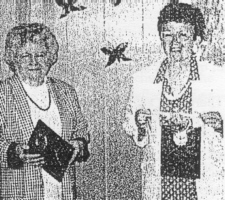
Ruth Zepplin & Joan Smith
The Choir and Church Musicians were
a big part of the church from the very beginning. It would be impossible to name
all who sang in the choir or who may have been the directors. It is believed to
have been Mrs. J. M. Philpott who played the first organ. On the twenty-fifth anniversary,
Pearl Holmes, Mrs. Sadie Klinne, Mrs. Hoffman, D. V. Richardson and J. M. Philpoft
made up the choir for the dedication program of the present building. Fred W. Draper
was very handy with his hands and could make beautiul church furniture out of old
organs. Two of the things lie made were the baptismal font and a table. James Colby
held the record for having sung in the choir the longest, but Byron and Ruth Zepplin
must now hold that record. Byron sung for 46 years, retiring in 1997 and Ruth still
sings in the choir. But Ruth - did retire from directing the choir in 1997, serving
in that position for 46 years. Ruth Zepplin and Joan Smith have both been honored
for their dedicated work, Ruth as choir director and Joan for her years of service
as Sunday School Superintendent. It takes a lot of dedication from many people to
keep a choir going. There is practice every Saturday afternoon with extra practice
for other occasions.













